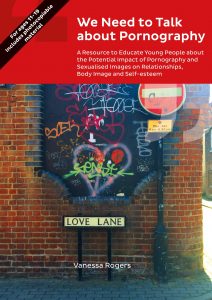 Vanessa Rogers, author of We Need to Talk about Pornography discusses the impact of pornography on young people’s wellbeing and relationships at a time when it has never been more accessible.
Vanessa Rogers, author of We Need to Talk about Pornography discusses the impact of pornography on young people’s wellbeing and relationships at a time when it has never been more accessible.
In 2014 the National Survey of Sexual Attitudes and Lifestyles (NATSAL) revealed that the average age in Britain to first have sex is 16. Whilst this may come as a surprise to some people, possibly swayed by the media portrayal of teenagers as hedonistic creatures, it adds weight to what many educators think; which is that whilst adolescence is a time for thinking and talking about sex (a lot in some cases!), not every teenager will have had sex underage. But whilst they may not all be ‘doing it’, there is strong evidence to suggest that the vast majority will have seen hardcore pornography by the time they start secondary school.
Conclusion? Children are likely to be watching adult material long before they are emotionally or physically ready for real-life sex.
As educators we sign up to the philosophy that children live what they see, so if porn is a major source of sex education, what exactly are they learning? That positive relationships are built on trust and mutual respect? That sex must always be consensual and should be mutually rewarding? That deciding when to have sex and who with is an important decision? I don’t think you get that type of SRE from watching porn.
As part of the research for my new book We Need to Talk about Pornography I was keen to know if national media stories about young people and porn were reflected in schools and youth centres across the UK. Whilst mobile devices are banned during school hours, many teachers expressed concern over what young people are watching online, the continued rise in popularity of selfies and social media and a seeming lack of pupil awareness about what is and isn’t an appropriate image to share.
‘For a generation used to learning online the boundaries between pornography and real life relationships can become blurred.’
This can lead to young people experiencing anxiety about what is considered ‘normal’ sexual behaviour, having unrealistic expectations of what a naked body should look like, including their own, and little concept of the deep emotions, positive and negative, that having a sexual relationship can provoke. Learning from porn fails to answer important questions and allows urban myths in an online world unchallenged by teachers and parents to thrive.
‘We wouldn’t want our children to learn about drugs from watching people taking them so why are we leaving a large part of sex education to pornography?’
I get it. Pornography is a difficult topic to talk about with young people. It raises moral and social questions and apart from the law, which is pretty clear on the subject, there are a lot of grey areas, which is why I have written my new book We Need to Talk about Pornography.
We Need to Talk about Pornography contains lesson plans to help young people understand how pornography can distort reality, how peer pressure and relationship bullying can push personal boundaries and the potential influence of the media and celebrity culture on creating social ‘norms’. It offers teachers and youth workers engaging and safe ways of discussing the potential consequences of sharing explicit selfies, sexting, and homemade porn, as well as unmasking how pictures and films are routinely edited – something which can impact on body image as young people compare themselves to an ideal that isn’t real. With information on the law and tips for informing parents and answering questions from young people, it aims to provide everything you need to talk about this tricky topic with confidence.
Whilst the jury is still out on the harmful effects of early exposure to pornography on adult relationships, UK based charity Safety Net asserts that pornography has a detrimental impact on children and young people, including premature sexualisation, negative body image and unhealthy notions about relationships[1].
So at a time when pornography is more accessible than ever, I think there is a definite need to include the impact and influence of pornography in PSHE. In short, we need to start talking about it, and we need to do it now.
[1] http://www.safetynet.org.uk/thefacts
We Need to Talk About Pornography is a practical educational resource that teachers and youthworkers can use to teach young people about pornography. The lesson plans and activities aim to open up discussions, explore values and attitudes, build personal skills and give information about what can be a difficult topic for professionals to talk about.